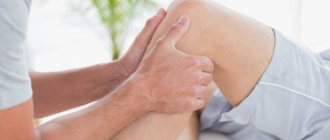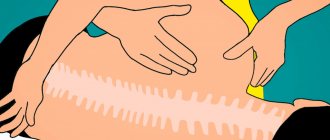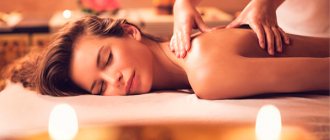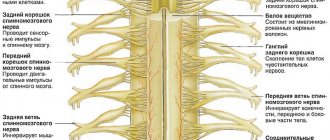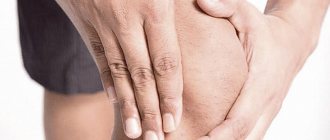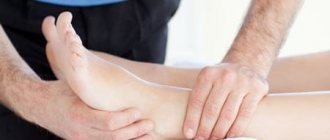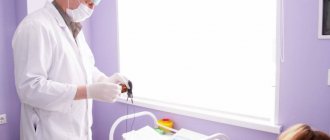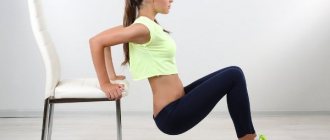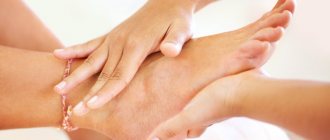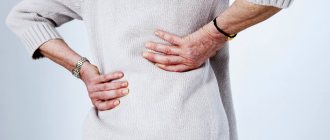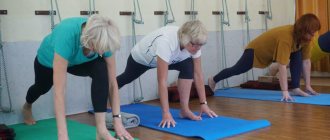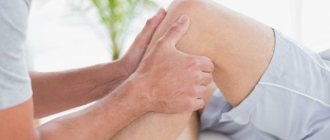Massage of the front and back surfaces of the neck, as well as the collar area, is performed for therapeutic and preventive purposes. Massage techniques accelerate blood circulation in muscle tissue and skin. Tight muscles on the back of the neck and collarbones, withers, and cervical osteochondrosis are the causes of disruption of the normal blood supply to the brain. These diseases provoke sleep disorders, chronic headaches (migraines), and changes in blood pressure. Neck massage relieves accumulated fatigue and muscle tension in people whose work takes place in a sitting position.
Is neck pain dangerous?
The cause of neck pain is often osteochondrosis. With this disease, the intervertebral discs are gradually destroyed. Painful sensations become chronic and interfere with life.
It is not recommended to endure pain, since with osteochondrosis they do not go away on their own. Experts recommend exercises for the neck and shoulders, as well as massage, which allows you to:
- Reduce inflammation;
- Improve blood flow;
- Relieve spasm;
- Reduce pain syndrome;
- Prevent pinched nerve endings.
Massage is an important component of treatment. It allows you to work the long neck extensors. Unlike medications, it has no side effects (if performed by a specialist following the techniques) and gives quick results. However, for a long-term effect, regularity is required.
But we must remember that there are different reasons for pain. Before a massage, you need to consult a doctor to make sure that there is no intervertebral hernia or subluxation of the vertebrae. Some pathologies allow the use of massage, for example, muscular-tonic syndrome, VSD, cervical scoliosis. But the presence of hernias, tumors, cysts requires additional examination.
Video from a neck massage session (cervical-collar area)
How is massage of the cervical-collar area beneficial?
Neck pain, pinched nerves, and muscle spasms can lead to such unpleasant consequences as migraines and insomnia. To get rid of these problems, a set of measures will be required. But moderate physical exercise aimed at stretching the neck muscles together with professional massage can give good results.
The correct neck massage technique gives the following effects:
- Relaxes muscles, relieves tension and spasms;
- Reduces pain and stiffness in muscles;
- Normalizes blood pressure;
- Reduces manifestations of osteochondrosis;
- Relieves stoop, straightens posture;
- Normalizes the functioning of the respiratory organs;
- Improves oxygen saturation of brain tissue;
- Removes excess fluid, eliminates swelling in the face;
- Increases performance, relieves fatigue, weakness, drowsiness during the day;
- Improves mood.
Massage of the neck, shoulders, and shoulder girdles has a beneficial effect not only on the muscular, but also on the nervous and circulatory system. Your appearance will also improve: your posture will become straighter, your withers (“widow’s hump”) will disappear, and your neck will become more flexible.
You can do massage not only when osteochondrosis has made itself felt. This is an excellent prevention of various pathologies. Preventing a disease can be easier than treating it.
Due to the fact that blood circulation improves, facial skin rejuvenates. Many beauty treatments begin with relaxing and rubbing the neck area. Over time, the skin of the neck becomes very thin and flabby. Plastic surgery does not always help solve this problem. Massage allows you to increase skin turgor, prevent sagging, and eliminate a double chin. Also, with age, a fatty hump appears in the area of the 7th vertebra. With the help of massage and simple exercises you can completely get rid of it.
Dynamic exercises
Such exercises for the treatment of cervical osteochondrosis involve performing various movements of the neck and head. Such gymnastics allows you to restore range of motion in this department and normalize blood flow.
You should not throw your head back as much as possible or rotate your head in a circle, this can lead to increased circulatory disorders, additional damage to the intervertebral discs, and exacerbation of the disease.
Starting position: sitting on a chair, back straight, legs slightly apart, upper limbs extended in front of the body. The hands are clenched into a fist, unclenched several times in a row, and at the end of the exercise you need to shake your hands.
Starting position: sitting, feet shoulder-width apart, upper limbs on the knees. You need to extend your right arm in front of you and move it to the side so that the upper limb is parallel to the floor. Then you need to perform a smooth turn of the body to the right from the described position. After returning to the original position, repeat this exercise on the opposite side of the body.
The initial position is sitting, legs bent at the knees, slightly apart, the upper limbs are at the waist. You should slowly tilt your head to the right and left shoulder alternately.
Starting position - sitting, arms bent at the elbows, hands located in the shoulder area. The bent upper limbs are raised parallel to the floor and slowly lowered to their original position.
In a sitting position, the head is slowly turned first to the left, then to the right, the body remains motionless.
Turns the head to the sides.
The starting position is sitting, at the same time you need to lean your hands on a chair on either side of your body. It is necessary to perform circular movements with the shoulder girdle, first in a clockwise direction, then in the opposite direction.
Starting position: sitting, upper limbs extended along the body. The right arm is extended in front of you to shoulder level, the palm is turned down. Simultaneously with this movement, the left straightened arm is pulled back, palm up. When performing the next repetition of this exercise, change the position of the upper limbs.
The initial position is sitting, the upper limbs are freely located along the body. The arms are bent at the elbow joints, making sliding movements with the hands on the sides of the body in the direction of the armpits. In the same way, the upper limbs are returned to their original position.
Initial position - a person sits, the upper limbs rest on the surface of the chair. You need to tilt your head, trying to reach your chin to your sternum. Then you need to smoothly return to the original position.
Bringing the chin to the sternum.
The initial position is sitting, you need to join the upper limbs in a lock, place them on your knees. The clasped straight arms are slowly raised to eye level, then smoothly lowered to the original position.
Indications and contraindications for massage
Massage of the cervical-collar area is a pleasant relaxing procedure. It can be carried out for prevention, simply to relax and relieve tension after a hard day, or to improve the condition of the skin. Medical indications for a massage course are:
- A sedentary lifestyle, working at a computer or other type of activity that requires maintaining an uncomfortable body position for a long time (seamstress, car mechanic, etc.);
- Stiffness and pain in the neck;
- Chondrosis and osteochondrosis;
- Appearance of withers;
- Chronic headaches;
- Scoliosis;
- Radiculitis;
- Dizziness;
- Disorders of the cardiovascular system;
- VSD (vegetative-vascular dystonia);
- Hypertension;
- Cerebral circulation disorders and decreased performance.
Sometimes massage is recommended for hernias or during the recovery period after injuries, but consultation with a doctor is necessary before the procedure. Contraindications for massage of the cervical-collar area are malignant benign tumors, pregnancy, thrombosis, hypertensive crises, serious mental damage, sexually transmitted diseases, instability of the cervical vertebrae, pregnancy, aneurysms, and severe blood diseases.
Technique for massage of the cervical-collar area: types of movements
The main task of a massage therapist is to improve blood flow in the neck and relieve muscle spasms. A massage always begins with preparation. The movements will be light, stroking to warm up the skin and muscles, and then gradually intensify. Before the procedure, it is advisable to take a shower and cleanse the skin of sweat and other contaminants. The specialist must use special gels or creams, oils that will allow the hands to glide over the skin. If the client is allergic to herbal or other components, it is worth informing about this in advance.
Massage of the cervical-collar area includes several types of movements:
- Stroking . The massage session begins and ends with these movements. With the help of stroking, the massage therapist relaxes the muscles and warms the skin. At this stage, you can already feel that the pain in the neck area is gradually decreasing. Strokes can be flat, superficial, deep, intermittent, or continuous, rake-like. The specialist selects their type and intensity for each client separately. It is important that the movements are quite intense, warm up well and prepare the skin and muscles for further manipulation, but they should not cause pain.
- Rubbing . The movements are similar to stroking, but they are more intense, warm up the skin and muscles more, and relieve spasm and pain. Rubbing can be straight, spiral or circular. Typically, types of movements are combined to enhance the warming effect.
- Kneading . This is the longest stage of the massage. The specialist begins to influence the muscles and ligaments. It grabs, lifts, and compresses tissue. There are transverse and longitudinal kneading. Such movements should not be too intense; they are performed at a slow pace and always use gel or oil. With each session, the intensity of kneading will increase.
- Effleurage . These are jerky movements that increase blood flow and improve muscle contractility.
During the massage process, the specialist can also use auxiliary movements, for example, rolling or vibration. Intense vibration is especially useful when you need to increase muscle tone. After vibration, percussive techniques, light tapping with fingers or the edge of the palm are used.
The specialist must well control and regulate the pressure on the skin and muscles so that the massage is quite effective, but does not cause severe pain to the client and does not leave bruises on the skin.
Sequence of manipulations
In order for the massage to bring maximum benefit, it is important to follow a certain sequence. Stroking movements should be replaced by rubbing, then kneading and rubbing again. After vibration, the final chord is stroking. This scheme will help a person relax, and at the end of the procedure, relax the muscles. Most of the time should be spent kneading. It is very important that all techniques are performed starting from the top and moving down. The first pass should be done vertically, in the second the movements should follow the line of the forearm.
Very important! Movements during a massage should never go from bottom to top!
Of great importance is not only how the actions are performed, but also how the patient is placed. It is not necessary for the person to lie down. The patient can be seated at a table on a chair or couch. You will need a pillow on which the patient will rest his head. The chin should be lowered and tucked towards the chest.
Features of the procedure
The course may include 10-15 sessions every 2-3 days. If the massage is performed for medical reasons, the doctor will adjust the duration of the course depending on the patient’s well-being.
The massage procedure has several features:
- Not only the professionalism of the massage therapist is important, but also a relaxing environment . Therefore, the room should have a comfortable temperature and pleasant music. Some massage therapists use incense.
- The massage is carried out using oils and creams, which also have a certain effect . For example, lavender in the composition relaxes, peach oil improves skin elasticity, etc.
- The duration of one session is approximately 30 minutes . For a child, the massage should last no more than 15 minutes.
- The specialist is obliged to pay attention to the patient's requests and comments . The procedure should not cause severe pain or discomfort.
- After finishing the massage, you need to get up very smoothly , slowly, without making sudden movements.
It is very important to contact a trusted specialist who knows how to massage a specific area and how hard to apply pressure to the skin and muscles. If the massage was done incorrectly or unprofessionally, migraines may appear or worsen, chronic diseases may worsen, or a sharp increase in blood pressure (hypertensive crisis).
Sometimes a massage therapist, in addition to oil and cream, uses additional products, for example, sea salt. It helps remove edema, reduces the manifestations of osteochondrosis, and breaks down fatty deposits. But you should not use even fine salt for people who have very thin or sensitive skin. This will lead to burning and irritation.
Also, natural honey is often used during massage if the client is not allergic to bee products. Honey improves the condition of the skin, has a good lifting effect, removes excess fluid and toxins, softens, and improves lymph flow. But in its pure form, honey is not applied to the skin; it will stick to your hands and interfere with stroking. It is heated a little to make it more liquid, and then mixed with butter or cream.
results
A relaxing procedure will restore normal muscle contractility. The patient will feel relief after the first session.
A cosmetic massage of the front and back of the neck will pleasantly surprise you with a visible positive result after 5-10 visits to a specialist.
Therapeutic massage is prescribed in combination with drug therapy and other treatment methods. Its effect depends on the diagnosis and general health of the patient. The results of the massage can be judged within 5-7 days after the start of complex therapy.
Since the neck is an important reflexogenic zone, an ineptly performed massage can provoke an exacerbation of the disease that you are so eager to get rid of. Therefore, in order to get the maximum effect and pleasure from the procedure, you need to contact only professionals in their field.
How to massage the cervical-collar area for children?
With the help of massage, you can eliminate the consequences of birth trauma in a child, improve the formation of posture, weaken the manifestation of VSD, improve academic performance, and normalize the psycho-emotional background. It is permissible to carry out the procedure even on infants older than 2 months.
The younger the child, the more careful the movements should be . The baby should be placed on his tummy, oil or baby cream should be applied, and then gentle gentle stroking and kneading techniques should be used. All movements must be smooth. You should avoid pressing hard. The duration of the massage should be 15-25 minutes depending on the age of the child.
If this is a junior schoolchild or preschooler, in addition to massage, you can do health exercises and stretch your neck with special exercises. Together with the massage effect, charging will give a good result.
A pediatrician can prescribe a massage after examination and medical history. Parents should tell the doctor if the child has problems with sleep, appetite, academic performance, or if he complains of pain. A visual examination will reveal curvature of the spine and salt deposits in the cervical-collar area.
If the massage is carried out correctly, the child’s sleep will normalize and headaches will disappear. The course can be repeated after six months to consolidate the effect.
